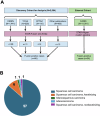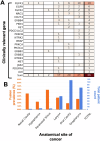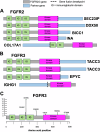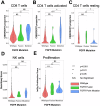Prevalence and biological impact of clinically relevant gene fusions in head and neck cancers
- PMID: 40610725
- PMCID: PMC12229568
- DOI: 10.1038/s41698-025-00889-7
Prevalence and biological impact of clinically relevant gene fusions in head and neck cancers
Abstract
Head and neck cancer (HNC) is the seventh most common cancer worldwide. Currently-approved systemic therapies include chemotherapy, anti-EGFR antibodies, and PD-1 immunotherapy, with few genomic-based targeted therapies. Gene fusions involving cancer-driving kinase genes such as FGFR, NTRK, and ALK are clinically targetable in other solid tumors; however, there is limited knowledge about their prevalence in HNC. Here, we describe the genomic landscape and the biological impact of oncogenic fusions in a combined dataset of over 13,000 HNC tumors (excluding salivary gland tumors). We identified 66 cases (2.8%) harboring oncogenic fusions, including previously-reported FGFR3 fusions (n = 19) and gain-of-function EGFR fusions (n = 6). Fusion-positive HNC had significantly higher gene expression and higher prevalence of human papillomavirus than fusion-negative HNC (p < 0.001). Tumors with FGFR alterations were associated with enriched cell proliferation and higher abundance of NK cells and CD8+ T cells compared to wildtype. Our results provide expanded therapeutic opportunities for patients with HNCs.
© 2025. The Author(s).
Conflict of interest statement
Competing interests: S.R. participated in Advisory Boards for Incyte Corporation (2017, 2023), AbbVie, Inc. (2017), QED Therapeutics (2018, 2019), Bayer (2020), Seagen (2023), Tyra Biosciences (2023), Taiho (2024). [Health care companies) (<10,000 USD). S.R. received honoraria from IDT Integrated DNA Technologies (2017), Illumina (2018). [Technology companies]. S.R. received consulting fees from QED Therapeutics (2018, 2019) and Merck (2019). [Health care companies] (<10,000 USD). S.R. received travel reimbursement from Incyte Corporation (2019)(Less than 999 USD). T.W.D. Consulting/Ad Board; Caris Life Sciences, NEED Inc, Merck & Co., EMD Serono, Adlai Nortye, Genmab, Replimmune; Stock: High EnrollClinical trial funding: Merck & Co., BMS, Janssen, AstraZeneca, Tesaro/GSK
Figures






References
-
- Hashibe, M. et al. Alcohol drinking in never users of tobacco, cigarette smoking in never drinkers, and the risk of head and neck cancer: pooled analysis in the International Head and Neck Cancer Epidemiology Consortium. J. Natl. Cancer Inst.99, 777–789 (2007). - PubMed
-
- Proia, N. K. et al. Smoking and smokeless tobacco-associated human buccal cell mutations and their association with oral cancer-a review. Cancer Epidemiol. Biomark. Prev.15, 1061–1077 (2006). - PubMed
Grants and funding
LinkOut - more resources
Full Text Sources
Research Materials
Miscellaneous

